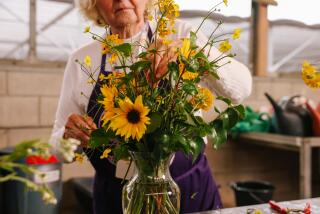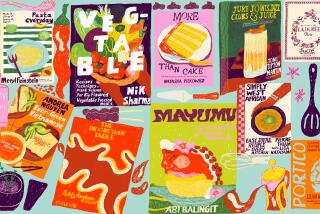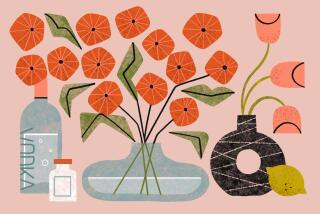FLOWER FOOD
- Share via
One morning not long ago, I went into my garden and discovered that overnight, everything had blossomed. The roses were in full bloom. The rosemary was bright with little blue flowers, the lavender had beautiful fragrant plumes, and sprays of blossoms covered the sage. Blue bouquets of star-shaped flowers crowned the prickly green foliage of borage plants. And the pansies were demurely showing off their velvety petals, colored burgundy and black, yellow and maroon, violet and deep purple. It was nature at its most extravagantly beautiful.
What I also realized was that all the flowers I was gazing upon could be used in cooking--in salads, in teas, to perfume a bowl of sliced peaches or simply to lend color to a finished dish.
Although it may seem trivial to use flowers in cooking, they serve many functions: The glowing colors lift our spirits; the fragrances have a tonic effect, and some flowers actually taste good.
Nasturtiums are particularly useful in the kitchen. The saucer-shaped leaves have a peppery quality like watercress; they are tender and lettuce-like, a wonderful addition to salads. The blossoms, delightful shades of gold, orange and cherry red, contain the peppery quality found in the leaves, only less pronounced. The petals can be sprinkled over a salad or mixed with butter to make a spread for tea sandwiches. The flower buds can be pickled and used in the same way as capers. Nasturtiums grow so easily and with such abandon that it’s easy to have loads of leaves and blossoms on hand. It’s a lovely old-fashioned flower that belongs in every garden.
Zucchini flowers are often used in Italy and are gaining in popularity here. Anyone with a zucchini plant growing in the garden can pick the male blossoms of the plant--those that do not ultimately bear fruit--to use in cooking.
The saffron-colored blossoms can be stewed in a little olive oil and onion to make a delicate dish with a light, vegetal flavor. Or the blossoms can be deep-fried, sometimes with a stuffing of fresh mozzarella and a touch of anchovy. Filled with ricotta, the blossoms can be cooked in a fresh tomato-basil sauce; cut into strips, they can be used as a sauce for pasta. When I first began traveling in Italy, zucchini blossoms were one of the things I looked forward to seeing in outdoor markets and ordering in restaurants--I was always thrilled at the sight of them and I still feel that way.
Borage, which grows wild in Sicily, produces beautiful blossoms with a light cucumber flavor that is surprising and delicious. I sometimes nibble on these flowers when I’m in the garden. They look lovely sprinkled over salads that contain thinly sliced cucumbers--the flavor of the flowers are an echo of the delicate flavor of cucumber. In addition, borage leaves can be cooked as a green. In Italy, they are combined with lentils to make a stew or combined with fresh ricotta to make gnocchi. If you plant one borage plant, by next year you will have more than you need, for this plant is self-seeding.
Of all the flowers used to perfume food, rose petals are surely the most popular. Their fragrance, with their notes of tea, berries and citrus, have an almost magical hold over our senses. Roses, in abundance during a long growing season that stretches from April to November, are used in many ways--in Turkish milk jelly and in jams, in cakes and marzipan candies, in custards and much more. One of my favorite ways to end a meal is a dessert of assorted berries, sugared and sprinkled with rose petals--the combined fragrance of berries and roses is the essence of summer.
A blossoming herb garden is as lovely as any flower garden, the plants covered with a profusion of blooms. The blossoms carry the fragrance of the herbs in a remarkably concentrated way. They make wonderful garnishes for foods. For example, sage blossoms look lovely garnishing a dish of ricotta-stuffed pasta served in a butter and sage sauce. They bring the color and scent of the herb garden to the table.
Orange and lemon blossoms and jasmine are all highly aromatic and all can be used in cooking. Orange and lemon blossoms make exquisite garnishes for granitas made of citrus juices. They can also be candied--the sugar actually preserves the fragrance. Jasmine flowers can be steeped in water over a period of days, then the fragrant water can be added to desserts--a custom in Sicily where jasmine-scented jelly, ice cream and granita are made.
Even those yellow mustard flowers that grow wild in the hills in springtime can impart flavor to food; the tiny petals carry the taste of the plant. They can be sprinkled over any foods that might enjoy a hint of the tangy flavor of the greens.
Be absolutely sure that the flowers you use are edible--there are many poisonous flowers. Avoid wild flowers growing along the roadside since they may be tainted with exhaust fumes. Do not use flowers that have been sprayed with pesticides, insecticides and fungicides. Never use flowers from the florist in cooking or as garnishes. To guarantee that the flowers you are using are free of dangerous residues, grow them yourself or use flowers grown by friends who follow natural methods of gardening.
And as for those edible pansies growing in my garden, I like to put them in a little vase on my windowsill, that is if I can get to them before the insects turn them into their picnic lunch.
In this lovely potato salad, neat little cubes of boiled potato are combined with dill pickles, pickled nasturtium buds and a lavish amount of chopped nasturtium leaves, which lend the salad a peppery bite. The small dice allows the dressing to be absorbed more fully into the potatoes. Arranged on an old-fashioned plate and garnished with nasturtium petals, blossoms and leaves, this makes a delightful salad to serve for lunch in the garden.
OLD-FASHIONED POTATO AND NASTURTIUM SALAD
1 1/2 pounds new potatoes, about 6 medium-small potatoes of even size
Sea salt
2 to 3 cups loosely packed tender nasturtium shoots, very young leaves and stems
1/2 cup chopped dill pickles
2 tablespoons pickled nasturtium buds or capers
1 small clove garlic, finely chopped
5 tablespoons extra-virgin olive oil
4 tablespoons red wine vinegar
Freshly ground black pepper
5 sprigs Italian parsley, finely chopped, about 2 tablespoons
Small handful nasturtium petals
Few whole flowers and leaves for garnish
Place potatoes in saucepan and cover with water by about 2 inches. Add 1 tablespoon sea salt. Cover pot and bring to boil. Uncover pot and cook at strong simmer about 20 minutes, or until potatoes are just tender. Test with small sharp knife. Drain potatoes and let cool.
When cool enough to handle, peel potatoes and cut into neat, small dice. Transfer potatoes to large bowl.
Chop nasturtium leaves and tender stems. Place in bowl with potatoes along with dill pickles, nasturtium buds and garlic. Add olive oil, vinegar and salt and pepper to taste. Toss gently, taking care not to crush potatoes.
Mound potato salad on serving plate and sprinkle chopped parsley over top. Cut petals into strips and sprinkle over salad. Garnish with whole flowers and leaves. Makes 6 servings.
This recipe features eggs hard-cooked just until the yolks are firm. The yolks are flavored with tender green herbs--green onion, chervil, Italian parsley--and young leaves and flowers of nasturtiums, which add a delightful pepper quality. I like to serve eggs with a little glass of chilled white wine, a nice foil for the richness of eggs.
EGGS STUFFED WITH GREEN HERBS AND NASTURTIUMS
2 eggs
3 to 4 small nasturtium leaves and tender stems, chopped
2 nasturtium flowers, cut into fine strips
1 sprig chervil, chopped
1 small sprig Italian parsley, leaves chopped
1 thin green onion, white and pale-green part only
Extra-virgin olive oil
Fine sea salt
Coarsely ground black pepper
Nasturtium leaves and flowers for garnish
Hard-cook eggs in boiling water just until yolks are firm, no longer. Cut each egg in half lengthwise and carefully remove yolk. Place yolks in small bowl and add nasturtium leaves, stems and flowers and chopped chervil, parsley and green onion. Mash with fork, adding enough olive oil to make paste. Season to taste with sea salt and pepper.
Lightly salt egg whites. Gently fill cavities with yolk-herb mixture. Grind some pepper over top. Arrange nasturtium leaves on plate and place eggs on top. Garnish with nasturtium flowers. Makes 1 to 2 servings.
A lovely dessert that is infused with the perfume of roses. Old-fashioned varieties of roses are most fragrant. If your rose petals are not intensely fragrant, you can add a little rose water to strained wine. If you do not have roses, simply prepare fruit, add one-half teaspoon rose water to sweet wine, then combine with fruit.
PEACH, STRAWBERRY AND CHERRY SALAD
Handful fragrant rose petals
3/4 cup good-quality dessert wine, such as Moscato d’Asti
1 basket strawberries
1/4 pound cherries
2 to 3 peaches
Rose petals for garnish
Crush rose petals and place in small bowl. Pour wine over petals and let stand in cool place 1 or 2 hours.
Hull strawberries and slice in half or in quarters. Stone cherries. Plunge peaches briefly in boiling water. Peel and slice. Place fruit in serving bowl and chill.
Strain wine and pour over fruit. Garnish with fresh rose petals. Makes 2 to 3 servings.
More to Read
Eat your way across L.A.
Get our weekly Tasting Notes newsletter for reviews, news and more.
You may occasionally receive promotional content from the Los Angeles Times.










